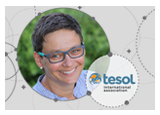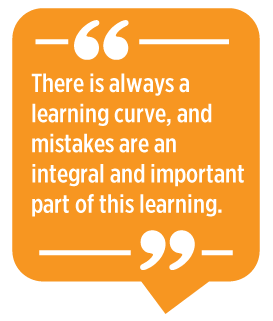|
 In my 25+ years in the profession, I have served in
numerous leadership roles in TESOL as well as outside TESOL. I have taken part
in leadership training opportunities, read on leadership, reflected on
leadership, and written on leadership. I have developed confidence in leading
people and have grown with every new leadership experience, TESOL presidency
being the far most educational of all of them. On the novice to expert scale
(Dreyfus, 2004), I would describe myself as proficient in leadership. In my 25+ years in the profession, I have served in
numerous leadership roles in TESOL as well as outside TESOL. I have taken part
in leadership training opportunities, read on leadership, reflected on
leadership, and written on leadership. I have developed confidence in leading
people and have grown with every new leadership experience, TESOL presidency
being the far most educational of all of them. On the novice to expert scale
(Dreyfus, 2004), I would describe myself as proficient in leadership.
Making Mistakes and Facing Challenges
With any new leadership position, we face new
tasks, challenges, practices, and relationships. There is always a learning
curve, and mistakes are an integral and important part of this learning. We
enter a new role knowing learning will happen. When it happens to me, I remind
myself of my favorite quote
on mistakes:
I hope that in this year to come, you make
mistakes.
Because if you are making mistakes, then you are
making new things, trying new things, learning, living, pushing yourself,
changing yourself, changing your world. You’re doing things you’ve never done
before, and more importantly, you’re Doing Something. (Gaiman, 2011)
I fully embrace these processes and have strategies
to turn challenges into opportunities for myself and others. However, I
currently face a leadership situation that has caught me off guard: The hard
learning is happening in a role and context I have established myself in—not in
a new leadership position.
Unexpected Changes in Familiar Contexts: Reasons for
Personal Growth
I have chaired the English Department at my university for 12 years, and
we are lucky to have had new hires in the past 3 years. The newcomers have
developed relationships among themselves and created a cohesive team that is
ready to support the vision for the department. Until now, I have always been
able to turn to two or three people for support in improving our second
language teacher education (SLTE) program quality. Now, I have four more.
Basically, half of my department is ready to act as a team and in alignment
with new research and current practices in SLTE—a dream come true.
 Yes, I am very lucky! Yet, I have been challenged
by this new reality. I am unexpectedly confronted with new dynamics in a very
familiar context. For such a long time, I have been leading and managing the
department in a certain mode that has helped me to bridge the existing gaps in
values and practices. The gaps still exist, but I suddenly have the majority of
my staff committed to the same vision. I have the foundation for synergy and
effective collaboration in the department (Zoglio, 2001) that I have never
experienced before. Yes, I am very lucky! Yet, I have been challenged
by this new reality. I am unexpectedly confronted with new dynamics in a very
familiar context. For such a long time, I have been leading and managing the
department in a certain mode that has helped me to bridge the existing gaps in
values and practices. The gaps still exist, but I suddenly have the majority of
my staff committed to the same vision. I have the foundation for synergy and
effective collaboration in the department (Zoglio, 2001) that I have never
experienced before.
Two recent events, an orientation for new students
and a collaborative project proposal, have unveiled that I am to face a big
learning curve that I primarily associate with new leadership positions. Group
reflections that followed both events provided me with feedback on my
leadership style and collaboration. They showed needs for my growth in the new
circumstances. I am called to adjust my leadership style and behaviors and find
new paths for leading and managing the department. The new conditions ask for
new approaches, which I will need to identify in the upcoming months.
My current leadership challenge reminds me that
learning never ceases—even in contexts we are well familiar with. It is
important to remain a student of what we are proficient or event expert in, be
it leadership or teaching.
References
Dreyfus, S. E. (2004). The Five-Stage Model of
Adult Skill Acquisition. Bulletin of Science, Technology &
Society, 24(3), 177–181. https://doi.org/10.1177/0270467604264992
Gaiman, N. (2012). My New Year wish. https://journal.neilgaiman.com/2011/12/my-new-year-wish.html
Zoglio, S. W. (2001). 7 keys to building
great workteams. https://www.agileconnection.com/article/7-keys-building-great-work-teams
Gabriela
Kleckova, PhD, is TESOL International
Association past president (2022–2023). She chairs the English Department at
the Faculty of Education, University of West Bohemia, in the Czech Republic,
where she also teaches second language teacher education courses. Her
professional interests include the effectiveness and utility of visual design
of ELT materials, teacher education, innovation in education, and leadership.
Her most recent publication, coedited with Justin Quinn, is titled Anglophone
Literature in Second-Language Teacher Education: Curriculum Innovation Through
Intercultural Communication (Routledge, 2021). For TESOL’s
50th anniversary, she was named one of 30 emerging leaders shaping the future
of the profession. |